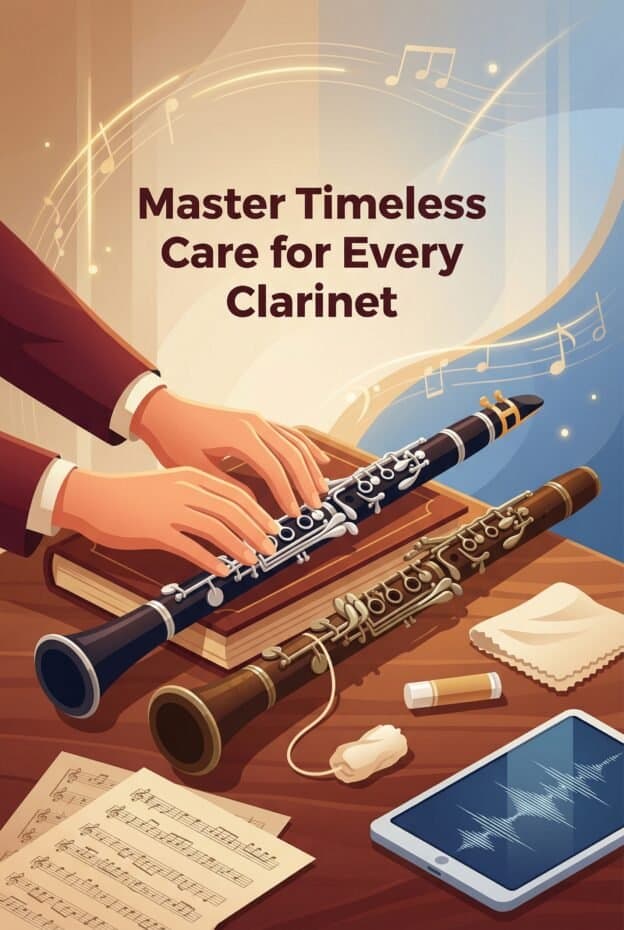Practical, historically informed clarinet maintenance uses gentle cleaning solutions such as vinegar and water at 1:3 or lemon and water at 1:4, a weighted silk swab or microfiber brush for moisture removal, small amounts of olive oil for conditioning wooden bores, beeswax-based cork grease, and heated animal-glue techniques only for historically important crack repairs, while modern synthetic adhesives and precision tools are preferred for most structural repairs.
Why Study Historical and Modern Clarinet Maintenance?
Clarinet maintenance has a 300-year history that links early makers like Johann Christoph Denner to modern workshops in Paris, New York, and Tokyo. Studying historical and modern methods helps players and technicians choose safe cleaning solutions, understand wood behavior, and decide when to use traditional materials or modern synthetics on both working and collectible instruments.
For an advanced hobbyist or semi-professional clarinetist, this context is not just academic. Historical methods explain why certain cracks appear, why tone holes wear the way they do, and how corks, pads, and keys evolved. That knowledge leads to better day-to-day care, fewer emergency repairs, and more informed decisions when restoring or conserving older clarinets.
Historical Overview: 18th to Early 20th Century Practices and Dates
By the early 18th century, the clarinet was a relatively simple wooden tube with a few keys. Makers in Germany and France used boxwood, fruitwoods, and later grenadilla. Maintenance focused on preventing cracks in the bore and at the tone holes, often with warm animal glue and oil-based varnishes applied as needed, especially in dry climates.
During the late 18th and early 19th centuries, as clarinets gained keys and became standard in orchestras, repair work became more specialized. Workshop records from cities like Paris and Vienna mention regular oiling of bores, re-seating of simple leather pads, and frequent crack sealing. Players used feathers and cords to clear tone holes and remove moisture after rehearsals and performances.
By the mid to late 19th century, with the rise of the Boehm system and industrial toolmaking, clarinet maintenance shifted toward more standardized methods. Custom reamers, pad cups, and knives appeared. Around the late 19th to early 20th century, cloth and felt pads became common, and technicians refined techniques for leveling tone holes and aligning keywork, shaping the maintenance routines we still recognize today.
Traditional Cleaning Solutions and Exact Ratios (Measurements to Preserve)
Historical clarinet maintenance often relied on mild, kitchen-level acids and oils. Surviving workshop notes from the 19th century mention diluted vinegar and lemon solutions for light disinfection and residue removal. These mixtures were never used straight on bare wood but carefully diluted and applied sparingly with soft cloths.
For practical modern use, two historically grounded ratios are especially useful. A vinegar solution of 1 part white vinegar to 3 parts water offers gentle cleaning for non-lacquered, unvarnished bores and metal parts. A lemon solution of 1 part lemon juice to 4 parts water provides similar mild acidity with a different scent profile, suitable for mouthpieces and some keys.
Apply either solution only to a lightly dampened cloth, never poured into the bore. Avoid these solutions on lacquered or heavily varnished interiors, as acids can cloud or soften coatings. For historical clarinets with delicate finishes, consult a conservator before using any liquid cleaner and favor dry methods whenever possible.
Cleaning Tools of the Past: Silk Swabs, Feathers, Cords & Weights
Before modern microfiber, clarinet players relied on silk, cotton, and natural feathers. A classic 19th century setup used a narrow silk cloth attached to a cord with a small lead or brass weight. After playing, the musician dropped the weight through the bore and pulled the silk through to remove moisture and residue.
Feathers, often goose or swan, served as flexible brushes for tone holes and tight spaces around keywork. Their natural taper allowed careful cleaning without scratching wood or metal. Workshop notes from German and French makers describe using feathers to clear dust from under keys and to wick moisture from problematic tone holes.
Some players also used soft cords alone, without cloth, to guide small patches of linen or silk through specific sections of the bore. These historical tools highlight two key principles that still apply: use soft, non-abrasive materials and avoid anything that can catch on posts, springs, or undercut tone holes inside the clarinet.
Historical Repair Techniques: Animal Glues, Heated Sealing, and Tool Notes
Before synthetic adhesives, clarinet cracks and loose joints were often treated with animal glues. Hide glue and fish glue were common. Technicians heated the glue gently, sometimes in small glue pots, then worked it into hairline cracks along the bore or around tone holes, wiping away excess and allowing the repair to cool and harden.
For more severe cracks, some 18th and 19th century workshops used a combination of warm glue and light clamping or binding with thread or wire. After curing, the area might be lightly scraped and retouched with varnish or oil. These repairs were reversible with heat and moisture, which is why conservators still value animal glue for historically significant instruments.
Tool notes from the period mention small knives, scrapers, and reamers specifically shaped for clarinet bores and tone holes. Craftsmen adjusted key fit and pad seats by hand, often under simple oil lamps or daylight. While effective, these methods depended heavily on skill, and repeated invasive work could gradually alter the original bore geometry.
19th Century Workshop Advances: Specialized Tools and Pad Materials
By the mid 19th century, clarinet maintenance benefited from industrial toolmaking. Workshops in cities like Paris, London, and Leipzig used precision reamers, pad cup mandrels, and custom screwdrivers sized for clarinet pivot screws. This allowed more consistent key alignment and pad seating across multiple instruments.
Pad materials also evolved. Early clarinets often used simple leather or bladder skins. Later 19th century makers introduced layered pads combining felt, card, and skin or cloth. These new pads sealed better and lasted longer, but they also required more careful leveling of tone holes and pad cups, which drove the development of finer files and measuring gauges.
By the early 20th century, cloth and felt pads were standard in many regions. Technicians heated shellac or similar adhesives to set pads into cups. This period established many of the pad and key maintenance techniques still taught in modern repair schools, including leak testing, spring tension balancing, and systematic regulation of the mechanism.
Modern Equivalents: Synthetic Adhesives, Microfiber Swabs, and Precision Tools
Modern clarinet maintenance blends historical insight with new materials. Microfiber swabs replace silk for many players, offering excellent moisture absorption with minimal lint. Weighted pull-through swabs remain standard, but their fabrics and stitching are optimized to reduce snagging inside complex keywork.
Synthetic adhesives, including epoxies and cyanoacrylates, provide strong, stable repairs when used correctly. For non-historic instruments, a carefully applied epoxy can stabilize cracks that might otherwise spread. For collectible or museum-grade clarinets, conservators still prefer reversible animal glues, reserving synthetics for non-invasive or fully documented interventions.
Precision tools now include digital calipers, leak lights, feeler gauges, and specialized screwdrivers. These allow technicians to measure pad heights, spring tensions, and bore dimensions with far greater accuracy than in the 19th century. Players benefit from more reliable keywork, stable tuning, and predictable response across the full range of the instrument.
Step-by-Step Maintenance Routine for Wooden Clarinets (Daily, Monthly, Annual)
A clear routine helps bridge historical practices and modern expectations. Wooden clarinets, whether grenadilla, cocobolo, or boxwood, respond best to consistent, gentle care. The following schedule balances moisture control, bore conditioning, and mechanical inspection without over-treating the wood or disturbing original finishes.
Daily Routine (After Every Playing Session)
1. Disassemble the clarinet and remove the reed from the mouthpiece.
2. Use a weighted silk or microfiber swab to dry the bore of each joint. Drop the weight through, pull the swab gently, and repeat once if needed. Avoid forcing a stuck swab.
3. Wipe the tenons and corks with a dry cloth to remove moisture and debris. Do not add cork grease every day unless the joints feel tight.
4. Lightly wipe the keys with a clean, dry cloth to remove fingerprints and sweat, especially on nickel or silver-plated keywork.
5. Place the reed on a flat, ventilated surface or reed case to dry. Do not store it on the mouthpiece.
Weekly Routine
1. Lightly clean the mouthpiece interior with a soft brush or feather and a cloth dampened with a 1:3 vinegar:water or 1:4 lemon:water solution. Avoid soaking the mouthpiece.
2. Inspect pads for moisture stains or lifted edges. Gently blot any damp pads with a clean cigarette paper or pad paper, avoiding pulling or twisting.
3. Check that all keys move freely. If a key feels sluggish, note its position for later cleaning rather than forcing it.
Monthly Routine
1. Condition corks lightly with beeswax-based cork grease or a modern equivalent. Apply a small amount, then work the joint together to distribute it evenly.
2. For non-lacquered wooden bores, apply a minimal amount of pure olive oil to a soft cloth or pull-through and pass it through the bore once. The surface should look slightly refreshed, not wet. Skip this step for instruments with sealed or heavily varnished bores.
3. Inspect the body for hairline cracks around tone holes, tenons, and the upper joint. Use a bright light to reveal fine lines. Record any changes in a simple maintenance log.
Annual (or Semi-Annual) Routine
1. Have a qualified technician or conservator perform a full inspection. Ask them to check for pad leaks, key alignment, bore wear, and developing cracks.
2. Replace worn pads, especially in high-use keys like throat tones and register key. Modern felt and synthetic pads can be chosen to match the instrument's period and playing needs.
3. For historical instruments or those showing cracks, discuss whether reversible animal-glue repairs are appropriate or if modern epoxies are acceptable, depending on the instrument's value and intended use.
Troubleshooting Common Problems: Cracks, Sticky Keys, Moisture & Reed Issues
Cracks, sticky keys, and moisture problems often share a common cause: inconsistent maintenance. Recognizing early symptoms allows players to intervene safely or seek professional help before damage becomes severe. Historically, many of these issues were handled with simple tools and careful observation, practices that remain useful today.
Hairline cracks usually appear near tone holes or tenons. Look for fine, dark lines that follow the grain. For a modern playing clarinet, temporary stabilization can involve gently humidifying the environment and avoiding extreme temperature changes. Structural repairs, whether with heated animal glue or modern epoxy, should be handled by an experienced technician.
Sticky keys often result from residue around pivot points or damp pads. Historically, feathers or soft brushes were used to clear debris. Today, you can carefully clean around posts and rods with a dry brush or feather. If a pad sticks to the tone hole, use pad paper to lift moisture and residue, never pulling sideways on the key.
Persistent moisture inside the bore suggests that the drying routine is insufficient. Increase the number of swab passes, and consider using a more absorbent microfiber swab. For players in humid climates, allow extra open-air drying time before storing the clarinet in its case.
Reed instability, such as sudden warping or inconsistent response, may stem from poor drying habits or uneven scraping. Historically, players made and adjusted their own reeds with knives and files. Modern players can still benefit from light hand-scraping to balance the reed and from rotating several reeds to reduce stress on any single one.
Reed and Mouthpiece Care: Making, Adjusting, and Maintaining Reeds
Reed and mouthpiece care has always been central to clarinet performance. In the 18th and 19th centuries, players typically made their own reeds from cane, adjusting them with small knives to suit specific mouthpieces and performance conditions. That tradition of fine adjustment remains valuable, even with factory-made reeds.
For daily care, rinse the mouthpiece with lukewarm water after playing, then dry it with a soft cloth. Avoid hot water, which can warp hard rubber. Once a week, use a diluted vinegar or lemon solution on a cloth to remove mineral deposits, taking care not to soak the table or rails.
Reeds should be rotated in sets of at least 3 to 4 for regular practice and performance. After playing, gently wipe excess moisture from the reed and place it in a ventilated reed case. If a reed feels unbalanced, a few light scrapes with a reed knife or fine sandpaper on the heart or tip can restore response, echoing historical reed-making practices.
For players interested in historical performance, experimenting with hand-shaped reeds and period-style mouthpieces can reveal how earlier clarinetists approached tone and articulation. Regardless of style, consistent reed care leads to more stable tuning, clearer articulation, and fewer last-minute reed emergencies.
Conserving Historical Instruments (Archive Best Practices and Martin Freres Legacy)
Historical clarinets, including many produced by Martin Freres and other European makers, require a conservation mindset rather than routine overhaul. The goal is to preserve original materials, tool marks, and acoustical design while preventing further deterioration. Every intervention should be documented and, when possible, reversible.
Environmental control is the first priority. Aim for stable relative humidity around 45 to 55 percent and moderate temperatures. Rapid swings in humidity or heat can trigger cracks in older woods such as boxwood or early grenadilla. Use display cases or storage cabinets that buffer environmental changes for museum or archive instruments.
Cleaning should be minimal. Dust can be removed with soft brushes and low-suction vacuum tools fitted with mesh screens. Avoid liquid cleaners on original finishes unless a conservator approves a specific method. When crack repairs are necessary, heated animal glues remain the preferred choice because they can be reversed with controlled heat and moisture if future research requires it.
For historically important Martin Freres clarinets, preserving original pads, springs, and corks may outweigh the desire to restore full playability. In such cases, technicians may create a detailed replica for performance while the original remains in a stable, documented state for research and exhibition.
Recommended Tools, Supplies Checklist, and Further Reading/Archives
A well-chosen toolkit supports both daily maintenance and historically informed repair decisions. Players do not need a full workshop, but a small set of reliable tools and materials can prevent minor issues from becoming major repairs. Technicians and conservation-minded players may expand this list as their skills grow.
Core Player Toolkit
– Weighted silk or microfiber swab suitable for your clarinet size
– Soft, lint-free cloths for keys and tenons
– Beeswax-based cork grease or high-quality modern cork grease
– Reed case with ventilation for at least 4 reeds
– Small soft brush or feather for keywork and tone hole cleaning
Extended Workshop Toolkit (For Technicians & Advanced Hobbyists)
– Leak light for checking pad seal
– Feeler gauges or thin paper strips for pad testing
– Small screwdrivers sized for clarinet pivot screws
– Reed knife or fine sandpaper for reed adjustment
– Animal glue granules and a small glue pot for historical repairs under guidance
– Selected modern adhesives (epoxy, shellac) for non-historic instruments
Further Reading and Archives
For deeper historical context, consult resources from the Library of Congress and the National Music Museum, which hold early clarinets, workshop documents, and treatises on woodwind performance. Many 19th century method books also include maintenance notes, reflecting the everyday practices of professional clarinetists of the time.
Key Takeaways
- Combine historical insight with modern materials: use mild acids, soft swabs, and reversible glues for valuable instruments, reserving strong synthetics for non-historic clarinets.
- Follow a clear routine: daily drying, weekly light cleaning, monthly cork and bore checks, and annual professional inspections extend instrument life and reliability.
- Prioritize conservation for historical clarinets: stabilize environment, minimize invasive work, and document every intervention, especially on instruments with archival or performance history value.
FAQ
What is clarinet maintenance?
Clarinet maintenance is the regular cleaning, drying, inspection, and occasional repair of the instrument's bore, keys, pads, corks, and mouthpiece. It includes daily swabbing, periodic cork and bore conditioning, and professional checks for cracks or pad leaks to keep the clarinet stable, responsive, and structurally sound.
How do I clean a wooden clarinet without damaging the bore?
Use a weighted silk or microfiber swab to dry the bore after each session, pulling it through gently without forcing. Avoid soaking the bore with liquids. For occasional cleaning, use a lightly dampened cloth on a pull-through, not poured solutions, and consult a technician before using any cleaner on lacquered or historical interiors.
What was used historically to seal cracks in clarinets?
Historically, craftsmen used heated animal glues such as hide or fish glue to seal cracks in wooden clarinets. They warmed the glue, worked it into the crack, sometimes applied light binding, and allowed it to cure before scraping and retouching. These glues are valued today for their reversibility on historically important instruments.
Can I use olive oil or household vinegar on my modern clarinet?
You can use small amounts of pure olive oil to condition non-lacquered wooden bores, applied sparingly with a cloth. Household vinegar is safe only when diluted, typically 1 part vinegar to 3 parts water, and used on a damp cloth for metal parts or mouthpieces, not poured into the bore or used on delicate finishes.
How can I dry the inside of my clarinet effectively?
Disassemble the clarinet and use a weighted silk or microfiber swab to pull through each joint once or twice after playing. Let the joints air dry briefly before returning them to the case. Avoid leaving a swab stored inside the instrument, which can trap moisture and encourage mold or wood movement.







